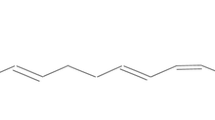Abstract
The study presents a case of non-fatal poisoning with oleander blooms in a 47-year-old female, with emphasis on the importance of toxicological service in a clinical emergency. After repeated vomiting at home, the patient was admitted at the hospital with cardiac symptoms more than 18 h after the ingestion. Serum samples were assayed immunochemically for digitoxin-related compounds by electrochemiluminescent immunoassay, and using HPLC/MS/MS analysis for oleandrin, the main cardiac glycoside of Nerium oleander. Confirming the non-specific immunoassay results, which are often clinically over-interpreted, oleandrin was detected by HPLC/MS/MS in the serum sample in a concentration of 1.6 ng/ml upon admission. Comparison with previous reports indicates that single compound analysis only permits a toxicological assessment for oleander poisoning and results in the proposal to classify an oleandrin level between 1.0 and 2.0 ng/ml as toxic blood plasma/serum concentration.


Similar content being viewed by others
References
Teuscher E, Lindequist U (1994) Biogene Gifte. Gustav Fischer Verlag, Stuttgart
Yamauchi T, Abe F, Tachibana Y, Atal CK, Sharma BM, Imre Z (1983) Quantitative variations in the cardiac glycosides of oleander. Phytochemistry 22:2211–2214
Eddleston M, Warrell DA (1999) Management of acute yellow oleander poisoning. Q J Med 92:483–485
Eddleston M, Rajapakse S, Rajakanthan S, Jayalath S, Sjöström L, Santharaj W, Thenabadu PN, Sheriff MHR, Warrell DA (2000) Anti-dioxin Fab fragments in cardiotoxicity induced by ingestion of yellow oleander: a randomised controlled trial. Lancet 355:967–972
Datta P, Dasgupta A (1997) Interference of oleandrin and oleandrigenin in digitoxin immunoassays: minimal cross reactivity with a new monoclonal chemiluminescent assay and high cross reactivity with the fluorescence polarization assay. Ther Drug Monit 19:465–469
Dasgupta A, Hart AP (1997) Rapid detection of oleander poisoning using fluorescence polarization immunoassay for digitoxin-effect of treatment with digoxin-specific Fab antibody fragment (ovine). Am J Clin Pathol 108:411–416
Jortani SA, Trepanier D, Yatscoff RW, Valdes R (1997) Convergence of three methods to resolve discrepant immunoassay digitoxin results. Clin Chem 43:1805–1808
Haynes BE, Bessen HA, Wightman WD (1985) Oleander tea: herbal draught of death. Ann Emerg Med 14:350–353
Shumaik GM, Wu AW, Ping AC (1988) Oleander poisoning: treatment with digoxin-specific Fab antibody fragments. Ann Emerg Med 17:732–735
Blum LM, Rieders F (1987) Oleandrin distribution in a fatality from rectal and oral Nerium oleander extract administration. J Anal Toxicol 11:219–221
Holstege DM, Francis T, Puschner B, Booth MC, Galey FD (2000) Multiresidue screen for cardiotoxins by two-dimensional thin-layer chromatography. J Agric Food Chem 48:60–64
Tor ER, Holstege DM, Galey FD (1996) Determination of oleander glycosides in biological matrices by high-performance liquid chromatography. J Agric Food Chem 44:2716–2719
Hamada K, Iwamoto A, Miyazaki S, Yamanaka N, Guruge KS (2002) Determination of bovine blood oleandrin by high-performance liquid chromatography and postcolumn derivatization. J Chromatogr Sci 40:515–518
Tracqui A, Kintz P, Ludes B, Mangin P (1997) High-performance liquid chromatography ionspray mass spectrometry for the specific determination of digoxin and some related cardiac glycosides in human plasma. J Chromatogr B 692:101–109
Tracqui A, Kintz P, Branche F, Ludes B (1998) Confirmation of oleander poisoning by HPLC/MS. Int J Leg Med 111:32–34
Wang XM, Plomley JB, Newman RA, Cisneros A (2000) LC/MS/MS analyses of an oleander extract for cancer treatment. Anal Chem 72:3547–3552
Arao T, Fuke C, Takaesu H, Nakamoto M, Morinaga Y, Miyazaki T (2002) Simultaneous determination of cardenolides by sonic spray ionisation liquid chromatography-ion trap mass spectrometry—a fatal case of oleander poisoning. J Anal Toxicol 26:222–227
Beike J, Frommherz L, Wood M, Brinkmann B, Köhler H (2004) Determination of aconitine in body fluids by LC-MS-MS. Int J Leg Med 118:289–293
Beike J, Karger B, Meiners T, Brinkmann B, Köhler H (2003) LC-MS determination of Taxus alkaloids in biological specimen. Int J Leg Med 117:335–339
Author information
Authors and Affiliations
Corresponding author
Rights and permissions
About this article
Cite this article
Pietsch, J., Oertel, R., Trautmann, S. et al. A non-fatal oleander poisoning. Int J Legal Med 119, 236–240 (2005). https://doi.org/10.1007/s00414-005-0548-6
Received:
Accepted:
Published:
Issue Date:
DOI: https://doi.org/10.1007/s00414-005-0548-6




